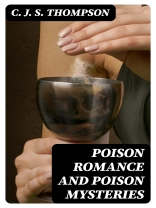In ‘Poison Romance and Poison Mysteries’ by C. J. S. Thompson, the author explores the intricate world of poison in literature, from its romanticized portrayal to its use as a mystery-solving tool. Thompson dissects various literary works where poison plays a crucial role, showcasing how authors manipulate this deadly substance to captivate readers. His writing style is meticulous and thought-provoking, delving into the dark and macabre themes associated with poison in a scholarly manner. The book provides a comprehensive look at poison in literature, shedding light on its symbolism and impact on storytelling. Poison Romance and Poison Mysteries is a fascinating read for anyone interested in the intersection of literature and toxicology. Readers will be engrossed by Thompson’s analysis of how poison adds depth and complexity to narratives, making this book a valuable addition to the study of literary themes and motifs.
Mengenai Pengarang
C. J. S. Thompson, whose contributions to the field of toxicology and cultural history remain noteworthy, was a British author extensively recognized for his detailed inquiries into the history of poison. Evidenced through his meticulous exploration in ‘Poison Romance and Poison Mysteries’ (1904), Thompson delved into the intricate and often macabre relationship humanity has had with poisons throughout the ages. His work captures not only the scientific understanding of poisonous substances but also the socio-cultural impact – exploring tales of infamous poisoners, the allure of secret formulas, and the dark romance associated with poison-related deaths. Thompson’s embarkation into the realm of poison was marked by a fascination with the methods and materials by which humans harm one another, and the paradoxical interplay between medicine and poison. His literary style, often scholarly yet accessible, allowed a broad audience to engage with what might otherwise have been an esoteric subject. While ‘Poison Romance and Poison Mysteries’ stands out as a cornerstone of his legacy, it also acts as a gateway to understanding the broader corpus of his work which often centered around historical medical practices, the evolution of pharmacology, and the anthropological significance of toxins. His depth of research and ability to weave complex narratives made him an important figure in historical literary circles, his work continually serving as a reference point for those interested in the darker corners of medicinal history.












